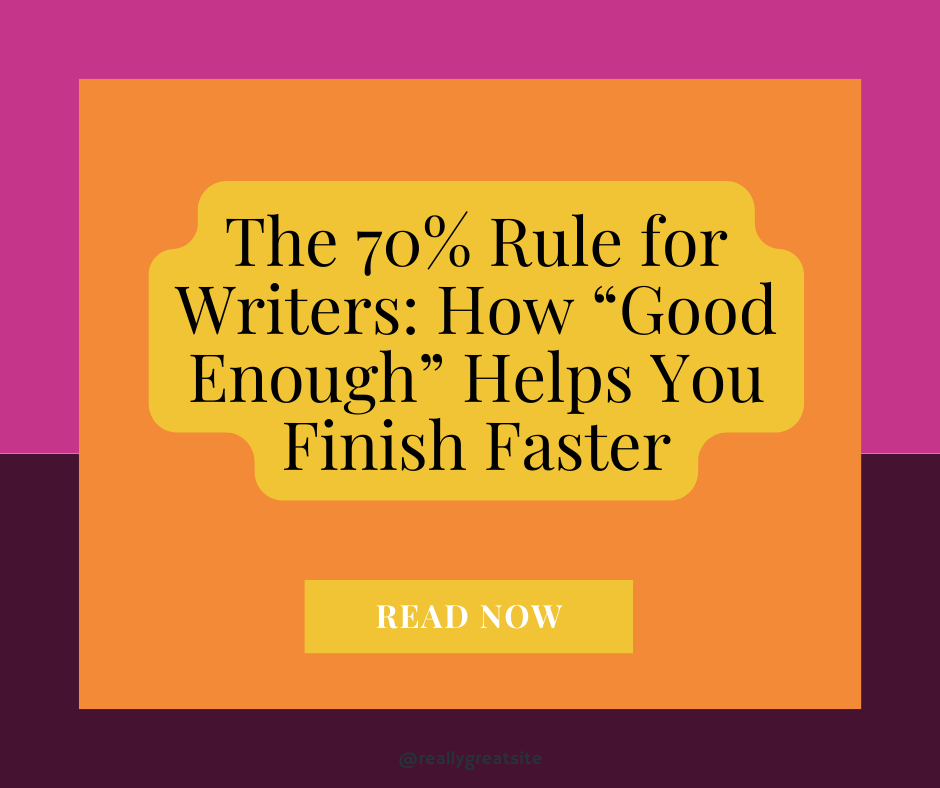Why I stopped aiming for perfect
I’ve reached a stage in my writing career where I no longer aim for 200% — or even 100% — the first time I do something.
These days, I aim for 70%.
It’s not laziness. It’s strategy. And it’s the main reason I finish more, stress less, and still produce work I’m proud of.
Before I adopted the 70% rule, I was doing “okay.” I had published books, I was relatively comfortable, but I still found myself slowing down on projects because I wanted them to be flawless before I released them.
Then I met someone who gave me permission to work differently.
The famous author who changed my mind
I can’t name her because of the private context we met in, but she’s hugely successful — multiple books adapted into films, international acclaim, the works.
She told me about a lunch with a friend, another equally famous author. Over their meal, she admitted that:
“This latest book… it’s not my best. I got it done, but it’s just okay. I know I’ve written better.”
Her friend replied:
“That’s all you had in you at that moment. And that’s fine. Over a career, you’ll write great books, average books, and the occasional terrible one. That’s why it’s called a career. This book is okay, but the next one might be incredible.”
That conversation was my turning point. She’d given me permission to release work that was “good enough” — not perfect — and move forward.
When research backed it up
A couple of years later, I saw a documentary featuring a Swedish professor of happiness (yes, really). He said something that echoed my author conversation:
“Aiming for 100% the first time is a recipe for stress. Aim for 70% — that’s OK.”
That grounded the rule in reality for me. It wasn’t just anecdotal wisdom, it was supported by research into happiness and productivity.
Why not go for 60%? I hear you ask. Because it’s unfinished. Why not 80%? Because you’re veering into perfectionism again, for me, anyway.
70% is the sweet spot: like a solid B+, where the work is functional, valuable, and ready to share.
How the 70% rule freed me from procrastination
Once I started aiming for 70%, I stopped:
- Waiting for the “perfect” mood to create
- Obsessing over small details before publishing
- Feeling crushed when a tech glitch or typo slipped through
- If a customer emails me about a broken link in a product, I fix it, but I don’t spiral into panic about what they might think. I see it as a natural part of doing business.
How I apply it to writing
Here’s what 70% looks like in my book-writing process:
1. First draft:
This is a brain dump. There’s no editing, no fixing typos, no overthinking. I just brain dump until I get to “The End”.
My AI tools help me shape my book idea and map out chapter summaries, so I always know where I’m heading. This way, I’m not distracted by sudden plot lines and random characterisations.
I write forward only, never back. I always pick up from the last session and I don’t review anything from my last session. Forward always.
2. Rest period:
When I get to “The End”, I leave the manuscript for two weeks to recharge creatively.
3. Self-editing pass 1:
I review for big picture: structure, pacing, plot holes.
4. Rest period 2:
Another one to two weeks away from the text.
5. Self-editing pass 2:
This is my final self-edit. I limit myself to three total passes so I don’t get stuck in endless tweaking.
6. Professional editing:
The manuscript goes to a developmental/structural editor. And yes, I always use editors. Writing and editing are two completely different skill sets.
Depending on the project, that might be two to four more edits, but the key is that by this point, it’s already “good enough” to move forward.
Objections I hear all the time
“Won’t this make my work mediocre?”
No. Awards, strong reviews, and reader engagement have come from projects I applied the 70% rule to. Mediocrity comes from lack of care, not from setting healthy boundaries.
“What if I damage my reputation?”
You control where you apply the rule. It’s not about being sloppy; it’s about intentional forward motion.
“Isn’t this cutting corners?”
No. Past a certain point, extra polishing produces diminishing returns. The 70% rule keeps you from crossing that line.
How you can apply it
- Pick one project you’ve been sitting on
- Ask: Is this clear, coherent, and valuable?
- If yes, release it at 70%.
- Get feedback, improve if needed, move on.
The bottom line
A 70% finished piece in your readers’ hands will always be worth more than a 100% perfect piece stuck in your head.
If you’re ready to move forward with confidence and without perfectionism, check out my Writer’s Rescue Kit.
It comes with 80+ battle-tested writing prompts, chapter starters, and transition phrases that professional authors use to break through creative paralysis and get back to writing, FAST.
